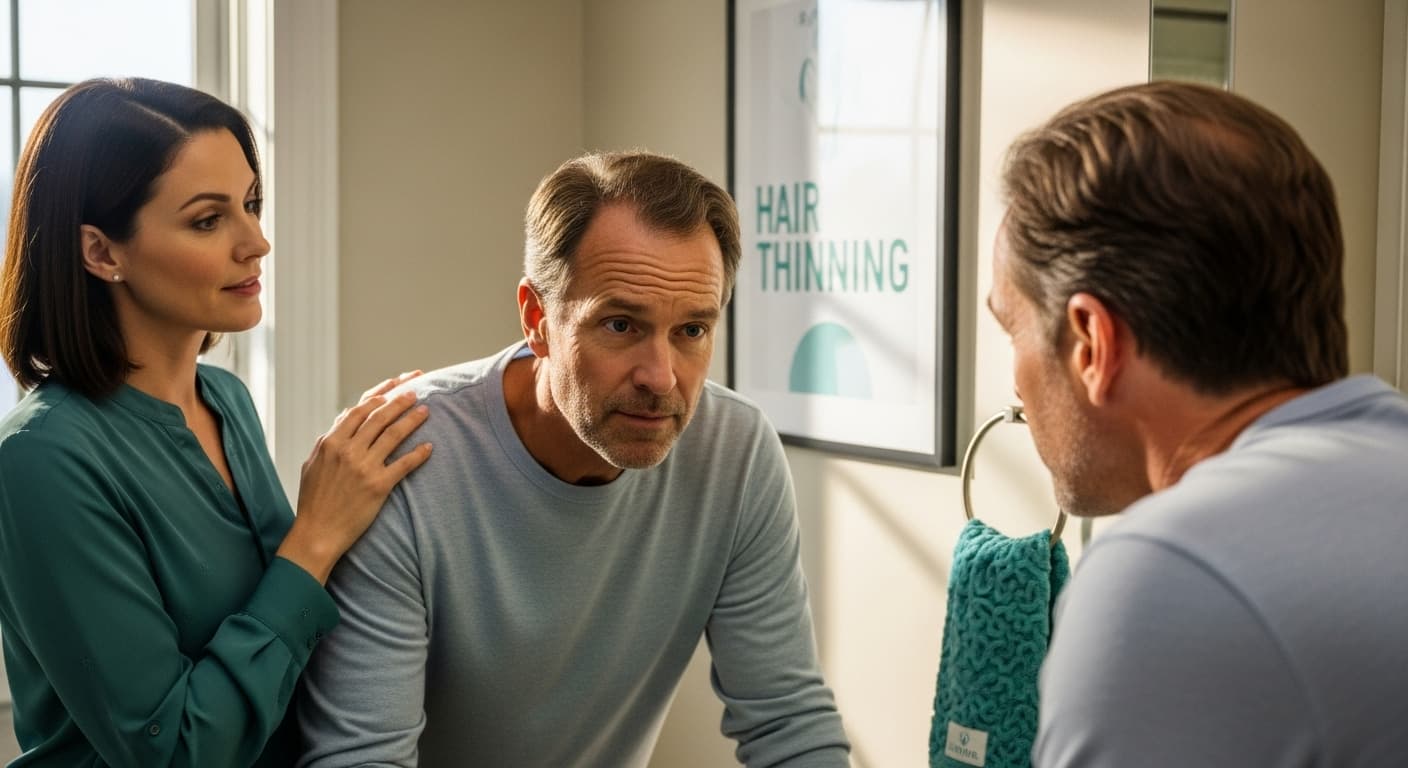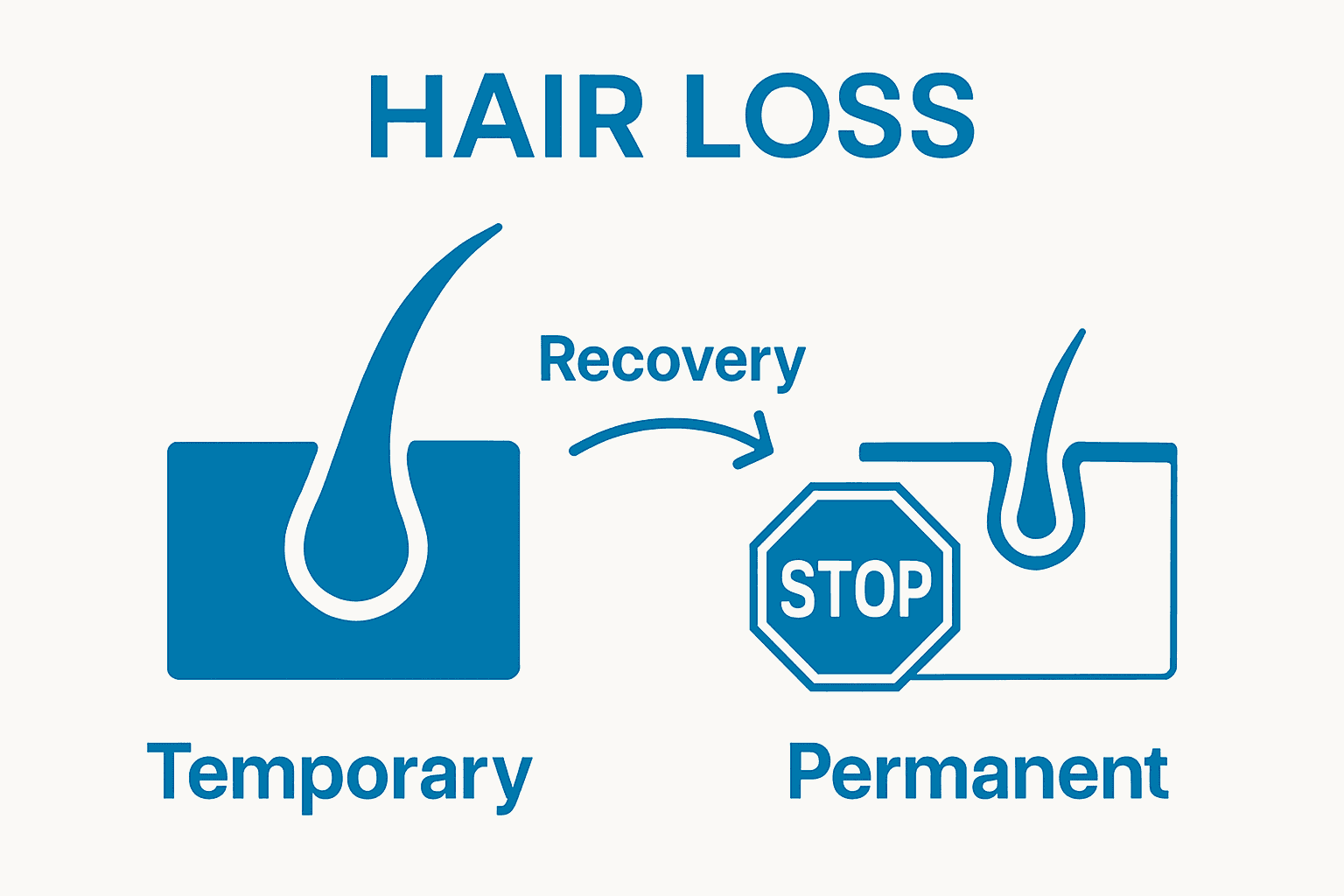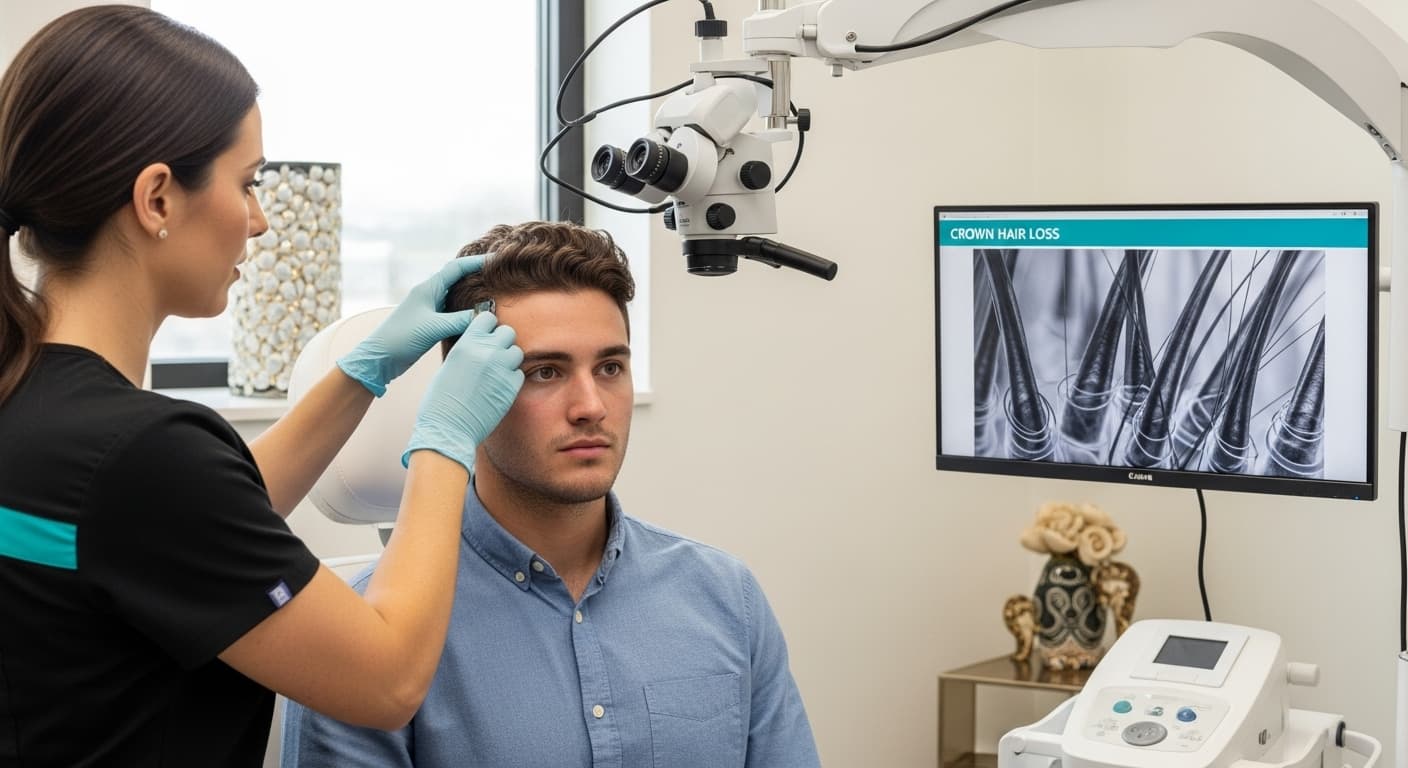Blog
Learning Materials
Understanding Hair Thinning at Crown Male: Causes and Effects
Updated: September 12, 2025

Lots of men notice their hair getting thinner right at the very top of their head and wonder if it’s normal. Most people do not realize that about 30 to 50 percent of men show signs of crown hair thinning by age 50. Everyone talks about genetics or stress but the real surprise is just how predictable and patterned this process is—even if you feel like you are the only one dealing with it.
Table of Contents
- What Is Hair Thinning At The Crown In Males?
- Causes Of Hair Thinning At Crown: Biological Factors
- Psychological And Social Impact Of Hair Thinning
- How Hair Growth Cycle Affects Crown Thinning
- Temporary Vs. Permanent Hair Thinning: Understanding Differences
Quick Summary
| Takeaway | Explanation |
|---|---|
| Crown hair thinning is common in men. | This condition primarily affects the vertex area, leading to noticeable hair loss in males, known as androgenetic alopecia. |
| Genetics play a crucial role in hair loss. | A family history of hair thinning significantly increases the likelihood of experiencing similar hair loss patterns. |
| DHT hormones contribute to hair miniaturization. | Dihydrotestosterone (DHT) binds to hair receptors, causing follicles to shrink and leading to reduced hair density. |
| Emotional impacts can affect self-esteem. | Men with crown thinning often report decreased confidence and social anxiety due to perceived changes in attractiveness. |
| Temporary thinning differs from permanent loss. | Temporary hair shedding, often reversible, contrasts with permanent thinning, which involves irreversible follicle miniaturization. |
What is Hair Thinning at the Crown in Males?
Hair thinning at the crown represents a specific pattern of hair loss predominantly affecting men, characterized by progressive reduction of hair density at the top of the scalp. This condition, medically known as vertex baldness, is a hallmark of androgenetic alopecia or male pattern baldness.
Understanding Crown Hair Loss Mechanisms
The crown region, scientifically termed the vertex, is particularly susceptible to hair loss due to complex hormonal and genetic interactions. Research from the National Institutes of Health indicates that dihydrotestosterone (DHT), a potent androgen hormone, plays a critical role in triggering hair follicle miniaturization. When DHT binds to hair follicle receptors, it initiates a progressive shrinking process that ultimately leads to reduced hair growth and eventual baldness.
Key characteristics of crown hair thinning include:
- Gradual reduction in hair density
- Increased scalp visibility
- Progressive miniaturization of hair follicles
- Symmetric pattern of hair loss
Progression and Genetic Factors
Male crown hair thinning follows predictable patterns defined by the Norwood-Hamilton classification system. This system helps medical professionals understand and categorize the extent of hair loss. Genetic predisposition significantly influences an individual's likelihood of experiencing vertex baldness. If close male relatives have experienced similar hair loss patterns, the probability of developing crown thinning increases substantially.
While numerous factors contribute to hair thinning, genetic inheritance remains the primary determinant. Our comprehensive guide on understanding male pattern baldness provides deeper insights into the intricate mechanisms driving this common condition.
Causes of Hair Thinning at Crown: Biological Factors
Hair thinning at the crown emerges from intricate biological mechanisms involving genetic predisposition, hormonal interactions, and cellular transformations. Understanding these underlying factors provides critical insights into the complex process of male pattern baldness.
Genetic Predisposition and Hereditary Influences
Research from the National Institutes of Health reveals that androgenetic alopecia represents a highly heritable condition affecting approximately 30-50% of men by age 50. Genetic inheritance plays a pivotal role in determining an individual's susceptibility to vertex hair loss. Specific gene variations associated with androgen receptors and hair follicle sensitivity can significantly increase the likelihood of developing crown hair thinning.
Key genetic factors contributing to hair loss include:
- Inherited sensitivity to DHT
- Variations in androgen receptor genes
- Family history of male pattern baldness
- Specific chromosomal markers linked to hair loss progression
Hormonal Mechanisms and Cellular Transformation
Androgen hormones, particularly dihydrotestosterone (DHT), serve as primary biological drivers of crown hair thinning. DHT triggers a complex cascade of cellular changes within hair follicles, leading to progressive miniaturization. This process involves heightened 5-alpha reductase enzyme activity, which converts testosterone into DHT, subsequently binding to hair follicle receptors and initiating a progressive shrinking mechanism.
The cellular transformation involves:
- Reduced hair follicle size
- Shortened hair growth cycles
- Decreased melanin production
- Increased inflammation around hair follicles
Our comprehensive guide on rapid hair loss in males offers deeper exploration of these intricate biological processes that contribute to crown hair thinning.
Psychological and Social Impact of Hair Thinning
Hair thinning represents more than a physical transformation, encompassing profound psychological and social dimensions that significantly influence an individual's emotional well-being and self-perception. Understanding these complex emotional landscapes helps contextualize the deeper implications of hair loss beyond mere aesthetic changes.
Emotional and Self-Image Challenges
Research from the European Academy of Dermatology reveals that hair plays a crucial role in personal identity and attractiveness. Men experiencing crown hair thinning frequently encounter complex emotional responses ranging from mild concern to significant psychological distress. The progressive nature of hair loss can trigger deep-seated anxieties about aging, masculinity, and personal attractiveness.
Key emotional challenges include:
- Decreased self-confidence
- Heightened social anxiety
- Persistent preoccupation with appearance
- Fear of perceived unattractiveness
- Feelings of vulnerability and reduced masculinity
Social Perception and Professional Impact
Hair thinning can subtly yet significantly influence social interactions and professional opportunities. Many men report experiencing subtle but perceptible shifts in social dynamics, including potential discrimination or unconscious bias in professional settings. The visible manifestation of hair loss can inadvertently trigger stereotypes about aging and perceived vitality.
Critical social perception factors encompass:
- Potential workplace perception changes
- Subtle shifts in romantic relationship dynamics
- Increased self-consciousness in social environments
- Potential challenges in career progression
Our comprehensive guide on understanding thicker hair for men provides additional insights into navigating these complex emotional landscapes associated with hair transformation.
How Hair Growth Cycle Affects Crown Thinning
The hair growth cycle represents a complex biological process that profoundly influences hair density and pattern, particularly in areas susceptible to male pattern baldness. Understanding these intricate mechanisms provides critical insights into the progressive nature of crown hair thinning.
The following table organizes the key phases of the hair growth cycle and explains how each phase relates to crown hair thinning.
| Phase | Description | Relevance to Crown Thinning |
|---|---|---|
| Anagen | Active growth phase | Shortens with DHT influence, limiting length |
| Catagen | Regression, end of active growth | Transitions to telogen more quickly |
| Telogen | Resting/dormancy phase | Prolonged duration leads to more shedding |
Phases of Hair Growth and Transformation
Research from the National Institutes of Health demonstrates that the hair growth cycle consists of three distinct phases: anagen (growth), catagen (regression), and telogen (resting). In healthy hair, these phases operate in a balanced, predictable sequence. However, for men experiencing crown thinning, this delicate balance becomes significantly disrupted.
Key characteristics of the hair growth cycle include:
- Anagen phase duration determines hair length
- Catagen phase signals the end of active growth
- Telogen phase represents hair follicle dormancy
- Genetic factors influence cycle duration and regularity
Disruption of Hair Follicle Dynamics
Androgen hormones, particularly dihydrotestosterone (DHT), play a crucial role in modifying the hair growth cycle. DHT triggers a process of follicular miniaturization, progressively shortening the anagen phase and extending the telogen phase. This hormonal intervention causes hair follicles at the crown to produce progressively thinner, shorter hair strands before eventually ceasing production altogether.
Significant transformations in follicle dynamics involve:
- Reduced hair follicle size
- Shortened active growth periods
- Increased time in resting phase
- Gradual replacement of terminal hair with vellus hair
Our expert guide on hair follicle growth offers comprehensive insights into understanding and potentially managing these complex biological mechanisms affecting crown hair thinning.
Temporary vs. Permanent Hair Thinning: Understanding Differences
Hair thinning manifests in complex patterns, with some forms representing transient conditions while others signify permanent transformations.
Distinguishing between temporary and permanent hair loss becomes crucial for developing appropriate management strategies and understanding individual hair health trajectories.
To help readers easily compare the key differences between temporary and permanent hair thinning, the table below summarizes their distinct characteristics based on the article content.
| Type of Hair Thinning | Onset and Pattern | Causes | Duration and Recovery | Follicle Damage |
|---|---|---|---|---|
| Temporary (Telogen Effluvium) | Sudden, diffuse, uniform thinning | Triggered by stress, illness, or events | Usually resolves in 3–6 months | No permanent damage |
| Permanent (Male Pattern Baldness) | Gradual, localized at crown/temples | Genetic and hormonal (DHT) influences | Progressive, irreversible | Irreversible miniaturization |
Characteristics of Temporary Hair Thinning
Research from the Cleveland Clinic reveals that temporary hair thinning, often referred to as telogen effluvium, emerges from specific physiological disruptions. These episodes typically result from significant bodily stressors that temporarily interrupt the natural hair growth cycle, causing widespread but reversible hair shedding.
Key indicators of temporary hair thinning include:
- Sudden onset of diffuse hair loss
- Triggered by specific life events or stressors
- Uniform thinning across the scalp
- Potential recovery within 3-6 months
- No permanent follicle damage

Permanent Hair Loss Mechanisms
Permanent hair thinning, predominantly characterized by male pattern baldness, represents a progressive condition driven by genetic and hormonal factors. Unlike temporary hair loss, permanent thinning involves gradual follicular miniaturization and eventual cessation of hair production in specific scalp regions, particularly the crown and temples.
Significant characteristics of permanent hair thinning encompass:
- Genetic predisposition
- Hormonal influence from androgens
- Progressive follicle shrinkage
- Irreversible hair loss patterns
- Predictable progression based on inherited traits

Our comprehensive guide on normal hair fall provides additional insights into understanding the nuanced differences between temporary and permanent hair thinning patterns.
Regain Confidence: Take Control of Crown Hair Thinning
Are you noticing a gradual thinning at your crown or seeing increased scalp visibility? If reading about genetic factors, hormonal triggers, and the emotional challenges of male crown hair loss feels all too familiar, it is time to take action. Your hair's health affects not just your appearance but your confidence and sense of self. MyHair.ai empowers you with clear answers tailored to your unique situation. With precise AI-driven scans and personalized advice, our technology translates the complexities of androgenetic alopecia, DHT, and Norwood-Hamilton patterns into practical solutions you can trust.

Stop guessing about your crown thinning—get a scientifically backed assessment and custom recommendations in seconds. Visit MyHair.ai today to upload your scan and receive insights designed specifically for your genetic and hormonal profile. If you want to learn more about how your hair growth cycle impacts thinning, explore our expert advice on hair follicle growth. Ready to track real progress and discover what works for you? Experience personal support and smarter care at MyHair.ai now.
Frequently Asked Questions
What causes hair thinning at the crown in males?
Hair thinning at the crown in males is primarily caused by androgenetic alopecia, commonly known as male pattern baldness. This condition is influenced by genetic predisposition and hormonal factors, particularly the action of dihydrotestosterone (DHT) on hair follicles.
How can I tell if my hair thinning at the crown is temporary or permanent?
Temporary hair thinning is often characterized by sudden, diffuse hair loss triggered by physical or emotional stress and can typically resolve within a few months. Permanent hair thinning, on the other hand, is progressive and involves long-term changes in hair follicle size and function, often associated with genetic factors.
What are the psychological effects of hair thinning at the crown?
Hair thinning can significantly impact self-image and emotional well-being. Men may experience decreased self-confidence, increased anxiety about appearance, and even fears related to aging and masculinity as a result of visible hair loss at the crown.
Are there treatments available for male crown hair thinning?
Yes, several treatments can help manage hair thinning at the crown, including topical solutions like minoxidil, oral medications like finasteride, and hair transplant procedures. It's essential to consult a healthcare provider for personalized recommendations based on individual circumstances.